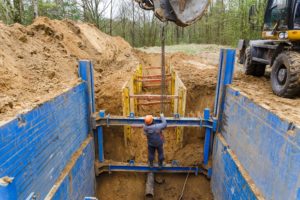Excavation and Trenching - Hazards and Safeguards

Excavation and trenching are cited by the Occupational Health and Safety Administration (OSHA) as being amongst the most hazardous work tasks undertaken in construction operations (OSHA, 2015). In fact, excavation work is attributed to having a 112% higher fatality rate than general construction work (OSHA, n.d.). So, what is the difference between excavation and trenching, and what hazards should construction industry workers be aware of and protected against?
Definition of an Excavation and a Trench
Any crater, hole, ditch, or gutter deliberately made by digging and removing soil or sand using tools, machinery, or explosives below the surface of the ground is defined as an excavation. A trench is an excavation that is narrow compared to its length. According to OSHA, “the depth of a trench is greater than its width, but the width of a trench (measured at the bottom) is not greater than 15 feet” (2015, p.1).
Excavations and trenching are most often carried out during building construction projects, in road repair work, when installing underground power lines, tanks, sewerage systems, etc.
Hazards Associated with Excavation and Trenching
There are several hazards that workers must be aware of, and where employers must provide relevant precautions to safeguard employees working in and around excavations and trenching operations. These are:
- Cave-ins – meaning the collapse of an excavation or a trench. This is a very common excavation hazard that can cause severe injuries and often result in fatalities at a job site;
- Asphyxiation – caused by a lack of oxygen due to a cave-in or the nature of a confined space;
- Hazardous atmospheres - due to toxic fume inhalation from underground gas pockets or even damage to underground gas pipes;
- Falling into excavations or trenches – especially if they are very deep;
- Falling objects;
- Falling loads - displacement of rocks, soil, and other materials from the excavation site edge falling on workers working at lower levels;
- Drowning;
- Incidents involving mobile equipment;
- Electrocution – due to underground power lines and underground utilities such as natural gas; and
- Explosions or fires.
Safeguarding Workers Against Excavation and Trenching Hazards
 OSHA has identified deficiency in the use of appropriate protective systems, failure to inspect trench and protective systems, unsafe spoil-pile placement, and unacceptable and insecure access and egress to excavation and trenches used by workers as the most common reasons for the accidents and deaths caused by excavation hazards (OSHA, n.d.).
OSHA has identified deficiency in the use of appropriate protective systems, failure to inspect trench and protective systems, unsafe spoil-pile placement, and unacceptable and insecure access and egress to excavation and trenches used by workers as the most common reasons for the accidents and deaths caused by excavation hazards (OSHA, n.d.).
Employers must adhere to the requirements of OSHA Standard 29 CFR 1926 Subpart P or comparable OSHA-approved state plans to safeguard employees undertaking excavation and trenching work in the construction industry.
Excavation Safety Methods
In general, OSHA recommends a trench that is deeper than 5 feet be outfitted with a protective system unless the excavation is made entirely in stable rock. For a trench that is less than 5 feet deep, a competent person may decide the need for a protective system. However, for a trench that is equal to or more than 20 feet deep, the protective system must be designed by a registered professional engineer or be aligned to the specification given by a registered professional engineer under OSHA standards 1926.652(b) and 1926.652(c).
OSHA also recommends the below methods to be used by employers to protect employees’ health and safety when they are engaged in excavation and trenching tasks.
Competent Person Inspection
All excavations and trenches must be inspected by a competent person before workers are allowed to enter such worksites. These inspections must be done daily, and any changes required to excavation hazard prevention methods should be executed to eliminate the threat of these excavation hazards to workers before they enter the excavation and trench site. A competent person is also required to inspect excavation sites after a rainstorm or flood to ensure the stability of the excavation before workers can begin work again.
Adequate and Clear Entry and Exits
Referred to as access and egress by OSHA, workers working in trenches and excavations must be given free and clear access to trenches by ensuring no blockage of entries and exists by materials, soil-pilling, or other tools and machinery. Workers working in trench excavations that are equal to or greater than 4 feet in depth must be provided with a ladder, a stairway, a ramp, or any other similar means to exit the excavation site.
Exposure to Falling Loads and Falling Objects
To safeguard workers against such dangers, heavy excavation equipment and materials should be kept away from the edges of excavation and trench sites. Excavated soil, stones, and other materials should also be kept at least 2 feet from trench edges to ensure such material does not slide and fall on workers who are working below. Employees should also be made aware to not work under suspended materials and loads.
Atmosphere Testing and Controls for Trenches and Excavation Areas
To ensure that workers are safeguarded against hazards such as explosions, fires, toxic emission inhalation, or asphyxiation excavations and trenches that are deeper than 4 feet must be tested for hazardous fumes, toxic gases, flammable gases, and low oxygen levels before workers enter the excavation area. Precautions such as respiratory systems and proper ventilation systems must be used when trenches and excavations deeper than 4 feet contain less than 19.5 percent of oxygen or the air is contaminated with poisonous gases.
Protective Systems to Prevent Cave-ins
 When deciding on a protective system, several factors including soil types, depth of excavation, the water content in the soil, adjustments for changing weather conditions, and use of materials and other equipment in the trench or excavation process must be considered.
When deciding on a protective system, several factors including soil types, depth of excavation, the water content in the soil, adjustments for changing weather conditions, and use of materials and other equipment in the trench or excavation process must be considered.
OSHA recommends one of the below protective systems to be used to safeguard workers against soil movement and cave-ins when they work in trenches and excavations.
- Benching trench walls – This involves shaping the excavation sides to resemble steps to prevent soil erosion and cave-ins.
- Sloping trench walls – The excavation sidewalls must be dug or cut at an angle inclined away from the base of the trench or excavation site.
- Shoring trench walls – Using external supports or other shoring systems made from aluminum or other strong material to brace excavation walls to prevent soil movement and cave-ins.
- Shielding trench walls – This involves supporting the excavation area sidewalls with trench boxes and other materials so that workers are safeguarded against cave-ins.
Worker Training
Training workers to understand the hazards and safeguards required when working at excavation and trench worksites is also important to ensure their occupational safety and health. OSHA recommends a combination of online training and on-site training that must be given to protect workers who are expected to work in and around excavations and trenches.
Our OSHA Competent Person For Excavation, Trenching, and Shoring online training course for individuals seeking certification for work in compliance with OSHA’s excavations regulations specified in 29 CFR 1926 Subpart P.
Enroll in this course today! This is your opportunity to learn more about excavation hazards and the safeguards that must be implemented when working in and around excavations and trenches. Our online training program comprises five lessons, and 8+ multimedia elements, and uses the innovative HAZWOPER media player (OSHA accepted) ensuring students stay engaged, are challenged, and obtain adequate knowledge.
References
- OSHA. (2011). OSHA Fact Sheet. Trenching and Excavations Safety [PDF]. Website. https://www.osha.gov/sites/default/files/publications/osha2226.pdf
- OSHA. (2015). Trenching and Excavation Safety [PDF]. Website. https://media.hazwoper-osha.com/wp-content/uploads/2020/02/13193515/osha2226.pdf
- OSHA. (2018). OSHA Fact Sheet. Working Safely in Trenches [PDF). Website. https://www.osha.gov/sites/default/files/publications/trench_safety_tips_card.pdf
- OSHA. (n.d.). Trenching and Excavation eTools. Website. https://www.osha.gov/etools/construction/trenching

